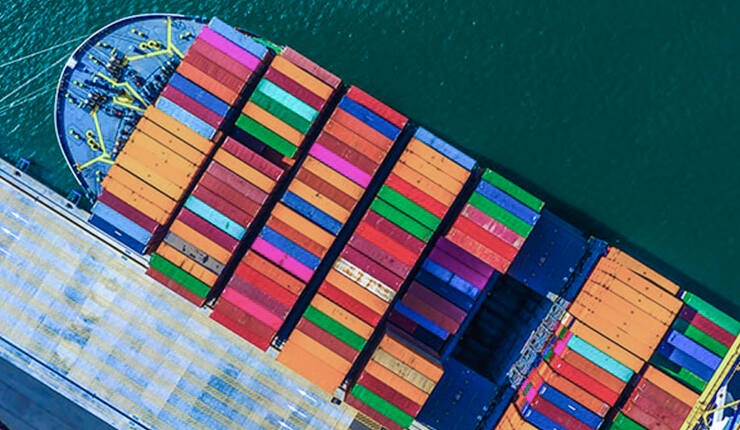With ocean freight shipping playing a major role in the supply chain, any disruption can quickly have a knock-on effect. After all, ocean freight is a volatile space where businesses are eager to secure container capacity and limit their expenses. When supply is low, however, just how can shippers satisfy their cargo needs, while managing costs and reliability?
For businesses operating internationally, container shipping can be a complex affair. To succeed in their import/export operations, SMEs and mid-caps dealing with overseas vendors and suppliers need to carefully monitor and manage the litany of shipping-related concerns they are often saddled with.
In this volatile sector, circumstances can change quickly, driving rates upwards and impacting profit margins. Factors such as container availability and bunker surcharges (due to changing oil prices) bear a direct impact on business shipping costs, meaning shippers need to remain savvy and develop market intelligence if they are to face the many challenges of the logistics industry. Of course, rates are not the only decisive factor for shippers, with additional – sometimes conflicting – concerns weighing in, notably when selecting a freight partner. Cost, capacity and reliability must all be accounted for.
As with all business operations, there are many ways to mitigate shipping’s many vagaries. Developing the right container shipping strategy, choosing the right partners and implementing best practices to guard against fluctuating overheads are essential. With a great number of international freight shipping companies, freight forwarders and ocean carriers to choose from, just where should a shipping-dependent business begin?
The ebbs and flows of contemporary maritime shipping
Until recently, ocean freight rates had become quite competitive, with shippers in a comfortable position to shop around for the pricing and service best suited to their containerised needs. Things began to change somewhat as of 2017, with the bankruptcy of some major carriers and the formation of new alliances. The Covid-19 pandemic and its continuing effects on trade have not only exacerbated recent challenges for shippers in an ever-changing ocean freight landscape, they have also started to shape a new future for supply chains around the world. While the reasons for rising costs are manifold, the current phenomenon boils down to the simple reality of growing demand and tightened supply.
On the carrier side, competition has indeed diminished. Since the bankruptcy of the world’s seventh-largest ocean carrier, South Korean freight company Hanjin in 2016, speculation has been rife about the next giant to capsize under the stress of rising tides. In a bid to pool their resources and stave off financial pressures, many shipping lines have formed large global alliances. 2017 saw the formation of two major carrier alliances, THE Alliance and Ocean Alliance. For shippers, these consolidations have had one immediate consequence, less leverage and room for rate negotiation.
The three major shipping alliances today:
- The Alliance
Hapag-Lloyd, Yang Ming Line, NYK Line, "K" Line and MOL.
- Ocean Alliance
CMA CGM, Evergreen Line, OOCL, APL and China Cosco Shipping. - 2M Alliance
Maersk and MSC.
Large-scale alliance formation and economic upheaval have also led to a radical decrease in capacity, with some shipping lanes now clearly favoured over others in a context of limited container availability. Indeed, at the onset of the Covid-19 pandemic in China in late 2019, the country reacted with drastic measures, shutting down entire cities and regions, which left many factories closed for business. By March 2020, lockdown measures were also adopted in many other parts of the world, including Europe and North America, which led to an immediate and considerable slump in demand. Carriers found themselves trying to maximise capacity and cover costs, ultimately cancelling some sailings entirely.
A pendulum swing in demand did little to improve things for shippers. When pent-up appetite for imports bounced back in June of the same year, carriers did not react with the same verve and actually continued to cancel sailings. This left shippers in the unenviable position of struggling to find freight options in a seller’s market. A shortage of containers has seen western shippers at a disadvantage, as carriers favour container routes moving goods from the Far East to the West, rather than the opposite. Since the start of the pandemic, prices have risen eight-fold with delays, closures and non-stop demand going strong. Some companies have even resorted to chartering their own cargo ships in an attempt to mitigate the supply chain crisis and save Christmas 2021. According to economists, the prices surges and goods shortages that have been brought on by the Covid-19 pandemic are not likely to be resolved before well into 2022.
|
Did you know? According to data-driven research tool Alphaliner’s global market share ranking, Ocean Alliance, 2M and THE Alliance account for roughly 80% of the global containerised shipping market. |
What can businesses do to mitigate shipping costs?
In an environment where container supply is limited and shipping demand has grown, ocean bidding becomes decidedly competitive. This is exactly what has unfolded in recent times, leaving shippers in a tight spot. But there are still ways for shippers to manage costs.
How to control ocean freight costs:
1. Freight cost bench-marking
-
Patience is a key asset to shippers operating in a seller’s market. Scarcity does not mean concessions should be made when it comes to securing a fair rate, so shippers need to remain informed of the prevailing market rates and resist blind acceptance.
-
Developing market intelligence is key to benchmarking. Businesses cannot know the rates competitors are paying unless they gain access. Several service providers offer market intelligence and analytics tools to help make data-driven assessments.
-
Detailed analyses of ocean freight spot rates and long-term contracted rates provide the insights needed to better negotiate and more effectively conduct budget forecasting.
2. Volume consolidation and partnerships
-
Consolidating cargo volumes typically offers certain advantages, such as reassuring carriers with a guaranteed base load, therefore facilitating the negotiation of longer rate and contract validity.
-
Not all shippers have steady, adequate volumes to pursue consolidation processes, so forming a consortium partnership with other shippers can help unlock these advantages. This leverages multiple shippers’ collective bargaining power.
-
Shipping partners with prior experience and previous contracts with ocean freight carriers can leverage this in pursuit of better rates or terms. The possibility of weighing different carriers and container lane options against one another also facilitates negotiation.
3. Consider a freight forwarder/NVOCC
-
If a shipper’s volumes are limited, but they wish to avail of advantageous rates, going through a freight forwarder or NVOCC (non-vessel-operating common carrier) may prove judicious. They work with a multitude of carriers and will seek the best solutions.
-
Shipping lines like to work with freight forwarders as they commit to guaranteed cargo volumes, but freight costs to the shipper are marked up. They can expand shippers’ ocean carrier base, granting them more leverage.
-
Freight forwarders can provide shippers with greater flexibility. A shipper working with a single carrier may find that container capacity is unavailable. In such instances, a freight forwarder will revert to another carrier they deal with. They do not operate their own vessels, however, so they cannot offer capacity guarantees in times of stretched demand.
4. Avoid hidden costs
- Rate negotiation is essential, but there can be hidden costs. Often, these only become apparent when there is an issue at the port of loading (POL) or port of discharge (POD). The reason can often be found in the contract terms, making it vital to read the fine print.
- Once a container has reached the wharf, it is usually held free of charge for a few days, but demurrage or detention fees are levied against shippers when this period is exceeded. Reasons for detention include incomplete documentation or a consignee’s slowness to conduct customs clearance. Random customs inspections can also occur.
-
Shippers must remain aware of port regulations and customs procedure for the jurisdiction they deal with. Demurrage and detention fees are determined in the shipping contract. Knowing local processes and how they will affect the likelihood of these occurrences is essential.
5. Explore risk management solutions
-
Ocean freight rates are typically negotiated in US dollars (USD). Currency risk is therefore a considerable factor when it comes to negotiating rates and paying shipping lines or freight forwarders. Paying in dollars can leave shippers exposed to FX fluctuations.
-
Some payment service providers (PSPs) offer immediate, multi-currency payment options, with exchange rates available in real time and full transparency over transaction-related fees.
-
FX risk management products are also a possibility. Forward payment contracts mean favourable exchange rates can be locked in and guaranteed for future payments. Dynamic forward payments offer this security, while also granting the possibility of capitalising on potentially advantageous currency market developments.
In today’s market, shippers need to consider all their options. Though it may seem tedious or costly, staying on top of contract terms and reaching out to third-party service providers can pay dividends in the end. It is important to maintain an incisive view and consider all potential costs, with market intelligence and creative solutions presenting themselves as natural allies to shippers in search of value and ROI.
|
Did you know? Just under 45% of container vessels arrived on schedule globally in December 2020, compared to over 76% one year prior, according to the findings of Copenhagen-based ocean freight data, analysis and advisory service Sea-Intelligence. |
What can businesses do to improve capacity and reliability?
Rates are not the only issue shippers have to grapple with. When containers are in high demand and shipping lines have suspended important sailings, securing capacity for shipments becomes an issue and turnaround pressure for carriers increases considerably. One of the major effects is a reduction in ocean freight reliability. So, how exactly does this play out? And what can shippers do to alleviate its impact?
Frequent issues faced by shippers:
- Rolled cargo
This describes when a container is not loaded onto the vessel it is supposed to due to issues like overbooking, customs setbacks or incomplete documentation.
-
Port skippingWhen a shipping line doesn’t stop at a scheduled port, it is referred to as “skipping”. This can occur due to scheduling issues and can result in cargo not being delivered on time, or being delivered at an alternative port.
-
Blank sailingThis is when an ocean carrier cancels a scheduled sailing, skipping either several ports along the way or the entire route. It can occur due to weak freight demand, which has made the scheduled sailing unprofitable.
-
Berthing delaysThis is when a vessel cannot unload its cargo on schedule, generally arising from congestion at ports and terminals.
As evidenced by some of the problems frequently encountered, shipping lines are habitually concerned that their sailings operate at maximum capacity, while shippers need to ensure reliability, so that shipments arrive on time and clients are not disappointed. However, ocean freight contracts traditionally operate as a statement of intent, rather than a binding commitment. Carriers regularly roll shipments and there’s rarely a penalty for it. Similarly, shippers are scarcely charged for not filling the capacity they have reserved with a carrier. This situation has changed in recent times, however, with both parties seeking increased redundancy and reassurance.
How to improve capacity/reliability:
1. Two-way commitments
-
Prompted by a parallel frustration – of rolled cargo on the shipper’s side, and unfulfilled capacity on the carrier’s side – there has been a new move towards more binding contracts, with greater enforcement of mutual commitments.
-
Broadly speaking, these consist of shippers committing to a certain level of freight volume for carriers, while the latter commit to shifting cargo at an agreed-upon rate, with related penalties reducing the risk of rolled cargo or skipping ports.
-
Companies specialised in offering these two-way ocean contracts have seen a surge in demand from shippers in recent times.
2. Tiered rates and index-linked rates
-
There has also been some rate-based innovation as of late, as many shippers have come to realise that year-long fixed rates have not guaranteed them desired capacity with many shipping lines.
-
Tiered-rate contracts offer greater adaptability. One rate is charged for fixed volumes on a specific shipping lane, but there is also a higher rate option offering enhanced flexibility in terms of final capacity, depending on how the shipper’s container needs evolve.
-
Index-linked rates operate differently. They fluctuate throughout the year, but not in an arbitrary fashion, as fluctuations are tied to well-known indexes, such as Drewry’s World Container Index or the Shanghai Containerized Freight Index.
3. Port bundling
-
Adopting this strategy ultimately consists of offering carriers greater choice and flexibility. Rather than limit themselves to one POL or POD, shippers identify several potential ports from which freight can be dispatched or received.
-
Designating one specific port due to proximity or practicality with regard to subsequent road freight can be short-sighted. It ignores factors like vessel scheduling and potential port skipping in cases of congestion, which can bear an impact on overall cost.
-
By accommodating carriers and opening up port possibilities, shippers are also able to choose from a broader range of shipping lines. This can create opportunities in terms of cost, capacity and scheduling.
As with costs, there are numerous ways to secure improved reliability from ocean carriers, but the concerns of shippers and shipping lines can sometimes clash. Two-way commitments and new rate models seek to better accommodate these antagonisms, for the benefit of both parties. Meanwhile, offering carriers a certain degree of flexibility in a time of limited resources is a sensible strategy to pursue.
|
Did you know? According to data collated by shipping analytics specialist firm Ocean Insights, over 20% of transshipped containers did not make their scheduled sailing departure in the second half of 2019. |
Ocean freight is an unpredictable sector, where changing environmental factors can quickly impact a business’s shipping performance. In recent times, competition among ocean carriers has lessened and containers have become difficult to secure. This limits shippers’ leverage and their ability to negotiate favourable rates, making it necessary to adopt intelligent strategies to reduce expenses on the one hand, and ensure service reliability and capacity on the other.
To reduce costs, there are myriad strategies businesses can pursue, from forming consortium partnerships with other shippers and using freight forwarders, to diversifying ocean carrier options and consolidating cargo volumes. Where reliability is concerned, shippers must consider that their need for dependability sometimes clashes with carriers’ requirements in terms of capacity fulfilment. These seemingly competing concerns make novel solutions like two-way commitment contracts and innovative rate models a welcome compromise for both parties.
Ultimately, shippers need to be creative. In a seller’s market, it is important to be flexible and accommodating, but there are still opportunities to optimise shipping operations. As cost savings go, FX risk management tools are often overlooked, but in a volatile field dominated by one global currency, it could make all the difference and help secure a business’s margins.
Topics






